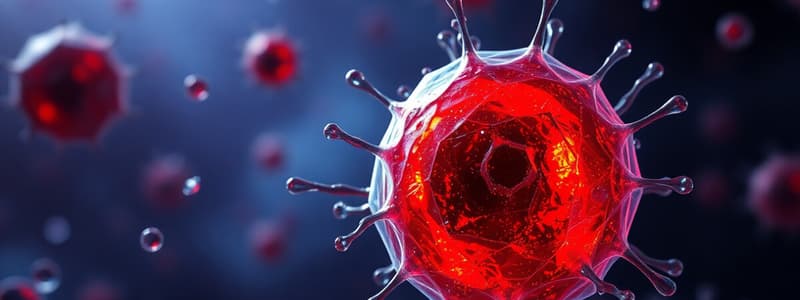Podcast
Questions and Answers
What is apoptosis?
What is apoptosis?
- A mechanism to repair damaged cells.
- A programmed form of cell death. (correct)
- A form of cell death due to injury.
- Cell division in response to stress.
Which example illustrates apoptosis?
Which example illustrates apoptosis?
- Old skin cells being replaced by new ones. (correct)
- Cancer cells proliferating uncontrollably.
- Blood vessel blockage leading to tissue death.
- Cells dying from bacterial infection.
What triggers the intrinsic pathway of apoptosis?
What triggers the intrinsic pathway of apoptosis?
- External immune response signals.
- Cellular exposure to hypoxia or radiation. (correct)
- Physical injury to the cell membrane.
- Cytokine release from damaged cells.
What role do Bax and Bak proteins play in apoptosis?
What role do Bax and Bak proteins play in apoptosis?
What is the outcome of the caspase cascade during apoptosis?
What is the outcome of the caspase cascade during apoptosis?
What is a characteristic outcome of necrosis?
What is a characteristic outcome of necrosis?
What happens to the proteins during the apoptotic process?
What happens to the proteins during the apoptotic process?
How does cytochrome C contribute to apoptosis?
How does cytochrome C contribute to apoptosis?
What characterizes caseous necrosis?
What characterizes caseous necrosis?
Which type of necrosis is primarily associated with trauma to fatty organs?
Which type of necrosis is primarily associated with trauma to fatty organs?
What is the primary cause of fibrinoid necrosis?
What is the primary cause of fibrinoid necrosis?
Which statement about apoptosis is true?
Which statement about apoptosis is true?
What type of necrosis is associated with hydrolytic enzymes?
What type of necrosis is associated with hydrolytic enzymes?
Which of the following statements best describes necrosis?
Which of the following statements best describes necrosis?
What effect does lipase have during pancreatitis?
What effect does lipase have during pancreatitis?
Which type of necrosis can be confused with cancer due to its appearance?
Which type of necrosis can be confused with cancer due to its appearance?
What is a common result of fat necrosis?
What is a common result of fat necrosis?
Which statement differentiates necrosis from apoptosis?
Which statement differentiates necrosis from apoptosis?
What happens to the cell membrane during apoptosis?
What happens to the cell membrane during apoptosis?
What type of protein is released by macrophages to initiate apoptosis?
What type of protein is released by macrophages to initiate apoptosis?
Which receptor is involved in the extrinsic pathway of apoptosis?
Which receptor is involved in the extrinsic pathway of apoptosis?
What is the primary mechanism by which necrosis occurs?
What is the primary mechanism by which necrosis occurs?
What initiates the caspase cascade during apoptosis?
What initiates the caspase cascade during apoptosis?
In which condition does coagulative necrosis most commonly occur?
In which condition does coagulative necrosis most commonly occur?
What characterizes liquefactive necrosis?
What characterizes liquefactive necrosis?
What is the primary outcome of oncosis?
What is the primary outcome of oncosis?
In what scenario would red infarcts appear?
In what scenario would red infarcts appear?
Which cell type is responsible for liquefactive necrosis in the brain?
Which cell type is responsible for liquefactive necrosis in the brain?
What type of necrosis primarily affects the lower limbs and gastrointestinal tract?
What type of necrosis primarily affects the lower limbs and gastrointestinal tract?
What role do immune cells play in necrosis?
What role do immune cells play in necrosis?
Which of the following is NOT involved in the extrinsic pathway of apoptosis?
Which of the following is NOT involved in the extrinsic pathway of apoptosis?
What happens to proteins during coagulative necrosis?
What happens to proteins during coagulative necrosis?
Flashcards are hidden until you start studying
Study Notes
Cell Death
- Two major forms of cell death: apoptosis and necrosis.
- Apoptosis is a programmed process, while necrosis is caused by injury or disease.
- Apoptosis occurs more frequently than necrosis.
Apoptosis: Intrinsic Pathway (Mitochondrial Pathway)
- Initiated by cellular stress, such as radiation, hypoxia, high calcium levels, and oxidative stress, and involves the mitochondria.
- Stress triggers Bax and Bak proteins to move from the cytosol to the mitochondria, making the outer mitochondrial membrane permeable.
- This releases SMACS and cytochrome C into the cytosol.
- SMACS deactivates proteins that inhibit apoptosis, while cytochrome C forms a complex called an apoptosome with ATP and Apaf-1.
- The apoptosome activates caspase-9, which in turn activates caspase-3 and other caspases.
- The caspase cascade dismantles the cell's nucleus, organelles, and cytoskeleton.
- This results in blebbing (bulges in the cell membrane), which attracts macrophages that clean up the cell fragments.
Apoptosis: Extrinsic Pathway (Death Receptor Pathway)
- Initiated by external signals, such as recognition of an old, pathogenic, or completed-task cell by macrophages.
- Macrophages release TNF-alpha, which binds to death receptors (e.g., tumor necrosis factor receptor 1) on the target cell.
- This activates the death domain protein of the receptor, leading to binding with FADD and TRADD.
- This forms the death-inducing signaling complex (DISC).
- DISC triggers the activation of caspase-8, which activates caspase-3 and sets off the caspase cascade, ultimately resulting in apoptosis.
- Similar process occurs when cytotoxic T cells detect foreign antigens and express Fas ligand that binds to the Fas receptor on the target cell.
- This activates the death domain protein of the Fas receptor, leading to DISC formation and apoptosis.
Necrosis
- Can be triggered by external factors (infection, extreme temperatures) and internal factors (tissue ischemia).
- Two primary forms:
- Oncosis: Damage to mitochondria disrupts ATP synthesis, leading to ion imbalance, cell swelling, and ultimately bursting.
- Inflammatory process follows as immune cells release proteases and reactive oxygen species, potentially causing tissue damage and organ dysfunction.
Types of Necrosis
- Coagulative Necrosis: Occurs when a tissue becomes hypoxic, caused by ischemia, resulting in protein denaturation and ineffective lysosomal enzyme activity.
- The tissue maintains some structure but becomes a gel-like substance.
- Red infarct: When blood re-enters the area of necrosed tissue, the tissue becomes dark red.
- Occurs in heart, kidney, and spleen tissues.
- Liquefactive Necrosis: Complete digestion of dead cells by hydrolytic enzymes, leaving a creamy substance.
- Found in the brain due to microglial cell activity (microglia are brain-resident macrophages).
- Can also occur in pancreatic cells (due to enzyme activity) or within abscesses (due to neutrophil proteolytic enzymes).
- Gangrenous Necrosis: Hypoxic condition that causes tissue drying (dry gangrene).
- Can progress to wet gangrene if infected, leading to liquefactive necrosis.
- Occurs in lower limbs and gastrointestinal tract.
- Caseous Necrosis: A mix of coagulative and liquefactive necrosis, in which dead cells disintegrate but aren't fully digested, causing a cheesy texture.
- Commonly associated with fungal or mycobacterial (e.g., Mycobacterium tuberculosis) infections.
- Fat Necrosis: Occurs in fatty organs like the pancreas or breasts due to trauma.
- Adipose cells rupture, releasing fatty acids into the extracellular space.
- Fatty acids bind with calcium, causing dystrophic calcification.
- Pancreatitis can also cause fat necrosis due to spillage of lipase.
- Fibrinoid Necrosis: Occurs in malignant hypertension and vasculitis.
- High blood pressure damages blood vessel walls.
- Fibrin infiltrates the walls, leading to destruction.
- Vasculitis also involves an inflammatory response in blood vessel walls.
Studying That Suits You
Use AI to generate personalized quizzes and flashcards to suit your learning preferences.


